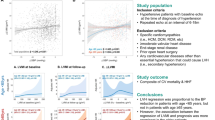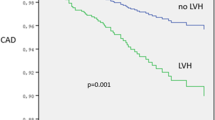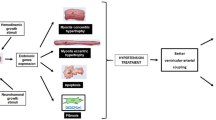Abstract
While left ventricular (LV) structure and function differ between hypertensive women and men, it remains unclear whether sex affects regression of LV hypertrophy with antihypertensive treatment. We analysed paired echocardiograms in 500 men and 347 women enrolled in the Losartan Intervention For Endpoint reduction in hypertension (LIFE) study at baseline and after 12 months of antihypertensive treatment with either losartan or atenolol. At enrolment, 177 women and 242 men were randomized to losartan-based treatment and 161 women and 247 men were randomized to atenolol-based treatment (sex difference=NS). After 12 months of antihypertensive treatment, blood pressure was lowered similarly in women (152/83 from 174/97 mmHg) and men (149/85 from 173/99 mmHg; both P<0.001, sex difference=NS), without significant change in body weight in either sex. Cardiac output and pulse pressure/stroke volume were equivalently reduced in both sexes (−0.2 vs −0.1 l/min and both –0.20 mmHg/ml/m2, respectively; both P=NS). Absolute LV mass change after 12 months of antihypertensive treatment was greater in men than in women (−30 vs −24 g, P=0.01). However, after adjusting for baseline LV mass and randomized study treatment, LV mass reduction was greater in women than in men (−33 vs −23 g, P=0.001). LV mass regression was greater in women, by 8.0±2.8 g, after adjusting for baseline LV mass and randomized study treatment. After consideration of baseline LV mass and randomized study treatment, antihypertensive treatment regressed LV hypertrophy more in women. Further studies are needed to identify the mechanisms and prognostic implications of this sex-related difference.
This is a preview of subscription content, access via your institution
Access options
Subscribe to this journal
Receive 12 digital issues and online access to articles
$119.00 per year
only $9.92 per issue
Buy this article
- Purchase on Springer Link
- Instant access to full article PDF
Prices may be subject to local taxes which are calculated during checkout

Similar content being viewed by others
References
Casale PN et al. Value of echocardiographic measurement of left ventricular mass in predicting cardiovascular morbid events in hypertensive men. Ann Intern Med 1986; 105: 173–178.
Koren MJ et al. Relation of left ventricular mass and geometry to morbidity and mortality in uncomplicated essential hypertension. Ann Intern Med 1991; 114: 345–352.
Liao Y et al. The relative effects of left ventricular hypertrophy, coronary artery disease, and ventricular dysfunction on survival among black adults. JAMA 1995; 273: 1592–1597.
Levy D et al. Prognostic implications of echocardiographically determined left ventricular mass in the Framingham Heart Study. N Engl J Med 1990; 322: 1561–1566.
de Simone G, Devereux RB, Daniels SR, Meyer RA . Gender differences in left ventricular growth. Hypertension 1995; 26: 979–983.
Krumholz HM, Larson M, Levy D . Sex differences in cardiac adaptation to isolated systolic hypertension. Am J Cardiol 1993; 72: 310–313.
Carroll JD et al. Sex-associated differences in left ventricular function in aortic stenosis of the elderly. Circulation 1992; 86: 1099–1107.
Douglas PS et al. Gender differences in left ventricle geometry and function in patients undergoing balloon dilatation of the aortic valve for isolated aortic stenosis. NHLBI Balloon Valvuloplasty Registry. Br Heart J 1995; 73: 548–554.
Gerdts E et al. Gender differences in systolic left ventricular function in hypertensive patients with electrocardiographic left ventricular hypertrophy (the LIFE study). Am J Cardiol 2001; 87: 980–983.
Liebson PR et al. Comparison of five antihypertensive monotherapies and placebo for change in left ventricular mass in patients receiving nutritional-hygienic therapy in the Treatment of Mild Hypertension Study (TOMHS). Circulation 1995; 91: 698–706.
Gottdiener JS et al. Effect of single-drug therapy on reduction of left ventricular mass in mild to moderate hypertension: comparison of six antihypertensive agents. The Department of Veterans Affairs Cooperative Study Group on Antihypertensive Agents. Circulation 1997; 95: 2007–2014.
Devereux RB et al. Effects of once-daily angiotensin-converting enzyme inhibition and calcium channel blockade-based antihypertensive treatment regimens on left ventricular hypertrophy and diastolic filling in hypertension: the prospective randomized enalapril study evaluating regression of ventricular enlargement (preserve) trial. Circulation 2001; 104: 1248–1254.
Dahlof B et al. The Losartan Intervention For Endpoint reduction (LIFE) in Hypertension study: rationale, design, and methods. The LIFE study group. Am J Hypertens 1997; 10: 705–713.
Dahlöf B et al. Cardiovascular morbidity and mortality in the Losartan Intervention For Endpoint reduction in hypertension study (LIFE): a randomised trial against atenolol. Lancet 2002; 359: 995–1003.
Wachtell K et al. Impact of different partition values on prevalences of left ventricular hypertrophy and concentric geometry in a large hypertensive population: the LIFE study. Hypertension 2000; 35: 6–12.
Devereux RB, Roman MJ . Evaluation of cardiac function and vascular structure and function by echocardiography and other noninvasive techniques. In: Laragh JH, Brenner BM, (eds). Hypertension: Pathophysiology, Diagnosis, and Management. Raven Press Ltd: New York, 1995, pp 1969–1985.
Devereux RB, Dahlof B, Levy D, Pfeffer MA . Comparison of enalapril versus nifedipine to decrease left ventricular hypertrophy in systemic hypertension (the PRESERVE trial). Am J Cardiol 1996; 78: 61–65.
Devereux RB et al. Relations of left ventricular mass to demographic and hemodynamic variables in American Indians: the Strong Heart Study. Circulation 1997; 96: 1416–1423.
Sahn DJ, DeMaria A, Kisslo J, Weyman A . Recommendations regarding quantitation in M-mode echocardiography: results of a survey of echocardiographic measurements. Circulation 1978; 58: 1072–1083.
Schiller NB et al. Recommendations for quantitation of the left ventricle by two-dimensional echocardiography. American Society of Echocardiography Committee on Standards, Subcommittee on Quantitation of Two-Dimensional Echocardiograms. J Am Soc Echocardiogr 1989; 2: 358–367.
Devereux RB et al. Echocardiographic assessment of left ventricular hypertrophy: comparison to necropsy findings. Am J Cardiol 1986; 57: 450–458.
Palmieri V et al. Reliability of echocardiographic assessment of left ventricular structure and function: the PRESERVE study. Prospective Randomized Study Evaluating Regression of Ventricular Enlargement. J Am Coll Cardiol 1999; 34: 1625–1632.
Reichek N, Devereux RB . Reliable estimation of peak left ventricular systolic pressure by M-mode echographic-determined end-diastolic relative wall thickness: identification of severe valvular aortic stenosis in adult patients. Am Heart J 1982; 103: 202–203.
Dubin J, Wallerson DC, Cody RJ, Devereux RB . Comparative accuracy of Doppler echocardiographic methods for clinical stroke volume determination. Am Heart J 1990; 120: 116–123.
Fagard RH, Pardaens K, Staessen JA, Thijs L . The pulse pressure-to-stroke index ratio predicts cardiovascular events and death in uncomplicated hypertension. J Am Coll Cardiol 2001; 38: 227–231.
Devereux RB et al. Echocardiographic left ventricular geometry in hypertensive patients with electrocardiographic left ventricular hypertrophy: The LIFE Study. Blood Press 2001; 10: 74–82.
Gardin JM et al. Left ventricular diastolic filling in the elderly: the cardiovascular health study. Am J Cardiol 1998; 82: 345–351.
Bella JN et al. Gender difference in diastolic function in hypertension (the HyperGEN study). Am J Cardiol 2002; 89: 1052–1056.
Schmieder RE, Martus P, Klingbeil A . Reversal of left ventricular hypertrophy in essential hypertension. A meta-analysis of randomized double-blind studies. JAMA 1996; 275: 1507–1513.
Municino A, Palmieri V, Dahlof B, De Quattro V et al. Impact of anti-hypertensive treatment on left ventricular geometric patterns: The PRESERVE study. Am J Hypertens 2000; 14(Part 2): 52A.
Capasso JM, Remily RM, Smith RH, Sonnenblick EH . Sex differences in myocardial contractility in the rat. Basic Res Cardiol 1983; 78: 156–171.
Scheuer J, Malhotra A, Schaible TF, Capasso J . Effects of gonadectomy and hormonal replacement on rat hearts. Circ Res 1987; 61: 12–19.
Grohe C et al. Cardiac myocytes and fibroblasts contain functional estrogen receptors. FEBS Lett 1997; 416: 107–112.
Villari B et al. Sex-dependent differences in left ventricular function and structure in chronic pressure overload. Eur Heart J 1995; 16: 1410–1419.
Querejeta R et al. Serum carboxy-terminal propeptide of procollagen type I is a marker of myocardial fibrosis in hypertensive heart disease. Circulation 2000; 101: 1729–1735.
Brilla CG, Funck RC, Rupp H . Lisinopril-mediated regression of myocardial fibrosis in patients with hypertensive heart disease. Circulation 2000; 102: 1388–1393.
Lopez B et al. Usefulness of serum carboxy-terminal propeptide of procollagen type I in assessment of the cardioreparative ability of antihypertensive treatment in hypertensive patients. Circulation 2001; 104: 286–291.
Acknowledgements
We thank Mary Paranicas, BA, Anne Morosky, BA, and Andreas Moan, MD, for their invaluable assistance with study coordination and Dawn Fishman, BA, for assistance in data management. We thank Paulette A. Lyle, BS, for assistance with the manuscript. Furthermore, we would like to thank the LIFE echocardiography study investigators.
Author information
Authors and Affiliations
Corresponding author
Additional information
Supported by Grant COZ-368 from Merck & Co., Inc., West Point, PA, USA.
Rights and permissions
About this article
Cite this article
Bella, J., Palmieri, V., Wachtell, K. et al. Sex-related difference in regression of left ventricular hypertrophy with antihypertensive treatment: the LIFE study. J Hum Hypertens 18, 411–416 (2004). https://doi.org/10.1038/sj.jhh.1001708
Published:
Issue Date:
DOI: https://doi.org/10.1038/sj.jhh.1001708
Keywords
This article is cited by
-
Regression of cardiac hypertrophy in health and disease: mechanisms and therapeutic potential
Nature Reviews Cardiology (2023)
-
Hypertension in women
Current Hypertension Reports (2009)
-
Hypertension in women
Current Cardiovascular Risk Reports (2008)
-
Management of hypertension in patients with left ventricular hypertrophy
Current Hypertension Reports (2007)



